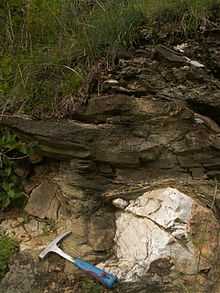Wetterstein limestone

Wetterstein limestone (German: Wettersteinkalk) and Wetterstein dolomite (Wettersteindolomit) are the most common names for a carbonate rock from the Middle Triassic epoch of the Ladinian stage, comparable to the German stage in which muschelkalk rock strata were formed.
Its subforms include: Messerstich limestone, Schlern dolomite, Marmolata limestone, Steinalm limestone and Ramsau dolomite.
The rock is found in the whole of the Alps, in many places as limestone (calcium carbonate), in many others as dolomite with a further element made of magnesium carbonate. Because, during dolomitization, traces of fossils are largely lost as a result of recrystallization, fossils in Wetterstein dolomite are harder to distinguish, and even in thin sections may be barely recognizable. Wetterstein dolomite is rarely as bituminous as typical main dolomite (Dolomia Principale Formation) and therefore tends to be much more pure and brighter-coloured. Otherwise, there are no fundamental differences with the Wetterstein limestone.
The rock gets its name from the Wetterstein mountains, because Wetterstein limestone has formed particularly big mountains here. The centre of its distribution, however, is in the Karwendel mountains. In many areas there is a frequent alternation of limestone and dolomite facies.
Sources
- McCann, Tom (2008). The Geology of Central Europe: Mesozoic and Cenozoic, Vol. 2, Geological Society; Pap/Cdr edition (Sep 2008), ISBN 978-1-86239-265-6